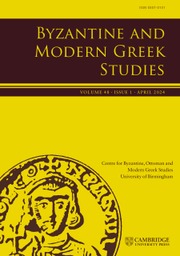No CrossRef data available.
Article contents
Byzantine excess, Slavic hesitancy: Euthymios of Tarnovo on visions
Published online by Cambridge University Press: 27 March 2025
Abstract
The medieval Slavs approached Byzantine speculative thought with caution. This essay explores Slavic hesitancy towards Greek theoretical ambition within the writings on visions of the Bulgarian theologian Euthymios of Tarnovo. Whereas the Greek hesychast theologian Gregory Palamas argued that the saints behold God's glory without mediation, Euthymios took a more modest approach, asserting that angels arbitrate between heaven and earth and bestow visions on the saints. Earlier scholars have described Euthymios as a ‘hesychast’, yet his views on visions align more closely with Palamas’ opponents and the Corpus of Pseudo-Dionysios.
- Type
- Article
- Information
- Copyright
- Copyright © The Author(s), 2025. Published by Cambridge University Press on behalf of the Centre for Byzantine, Ottoman and Modern Greek Studies, University of Birmingham
Footnotes
The author is grateful to Craig Duncan and David Goldfrank for commenting on the argument and translations.
References
1 See K. Ware, A Fourteenth-Century Manual of Hesychast Prayer: the century of St Kallistos and St. Ignatios Xanthopoulos (Toronto 1995).
2 On Hesychasm in relation to gold leaf, see Barber, C., ‘Out of Sight: painting and perception in fourteenth-century Byzantium’, Studies in Iconography 35 (2014) 107−20Google Scholar; on mandorlas, see Andreopoulos, A., Metamorphosis: the Transfiguration in Byzantine theology and iconography (Crestwood NY 2005) 83−100Google Scholar.
3 On Palamas, see Meyendorff, J., Introduction à l'étude de Grégoire Palamas (Paris 1959)Google Scholar.
4 On Palamas’ writings translated into Slavonic, see Scarpa, M., Gregorio Palamas slavo: la tradizione manoscritta delle opera: recensione dei codici (Milan 2012)Google Scholar.
5 Ivanova, K., ‘The New Redaction Tŭrnovo Collections and the role of Patriarch Evtimii in their translation’, in Bakalova, E., Dimitrova, M., and Johnson, M. A. (eds), Medieval Bulgarian Art and Letters in a Byzantine Context (Sofia 2017) 500−23Google Scholar.
6 On Euthymios within the Bulgarian hesychast literary movement, see K. Ivanova-Konstantinova, ‘Някои моменти на българо-византийските литературни връзки през XIV в.: Исихазмът и неговото проникване в България’, in B. S. Angelov (ed.) Старобългарска литература (Sofia 1971) 209−42.
7 Džurova, A., Томичов Псалтир (Sofia 1990) 102–3Google Scholar.
8 Džurova, Томичов Псалтир, 239.
9 Moses, who appears on the bottom right holding the scroll with Ps. 78:1, forms a transition between this miniature and the illustration of the next psalm, where he is bestowing the Law upon the Hebrew people.
10 However, the Spirit is not shown in the miniature. On the Paternitas, see Willson, J., ‘On the aesthetics of diagrams in Byzantine art’, Speculum 98.3 (2023) 763–801Google Scholar.
11 Euthymios of Tarnovo, Werke, ed. E. Kałužniacki (Vienna 1901) 206. (Hereafter ‘Euthymios’).
12 Euthymios, 206–7.
13 Euthymios, 207; the source of the quotation has not been identified.
14 On the vice of curiosity and speculation in the eyes of western medieval theologians, see H. Blumenberg, The Legitimacy of the Modern Age, tr. R. M. Wallace (Cambridge MA 1983) 229–456.
15 Euthymios, 211.
16 Euthymios, 211.
17 Euthymios, 212.
18 H. Goltz et al. (eds), Das Corpus des Dionysios Areiopagites in der slavischen Übersetzung von Starec Isaija (14. Jahrhundert) (Freiburg 2010–13).
19 See for an overview of angels, Peers, G., Subtle Bodies: representing angels in Byzantium (Berkeley 2001)Google Scholar.
20 Select scenes did appear: see e.g. E. G. Stika, Το οικοδομικόν χρονικόν της Μονής Οσίου Λουκά Φωκίδος (Athens 1970) 174–8, Pl A–B, fig. 92.
21 S. Gabelić, Византиjски и поствизантиjски циклуси арханђела XI-XVIII век (Belgrade 2004) 94–101 (Lesnovo); 102–7 (Matejić); 134–37 (a late fourteenth-century vita icon now at the Kremlin).
22 Parpulov, G., Magnificent Icons in Bulgaria (Sofia 2020) 60–61Google Scholar, cat. no. 16. See a later example in Bauer, S. and Böhler, B. A., Feuer und Geist: Ikonen aus der Schatzkammer des Bulgarischen Patriarchats (Vienna 2008) cat. no. 13Google Scholar.
23 Kydones, Prochoros, ed. Candal, M., ‘El libro VI de Prócoro Cidonio: sobre la luz tabórico’, Orientalia christiana periodica 20 (1954) 272Google Scholar. (Hereafter ‘Kydones’). Kydones is following Celestial Hierarchy 4.3–4, ed. G. Heil and A. M. Ritter, Corpus Dionysiacum II (Berlin 1991) 22–3.
24 Kydones, 294–6.
25 Gregory Palamas, Défense des saints hésychastes, ed. J. Meyendorff II (Louvain 1959) 555.
26 See S. Franklin, ‘On “philosophers” and “philosophy” in Kievan Rus’, in Byzantium-Rus-Russia: studies in the translation of Christian culture (Burlington 2002) 1–13 [Study 14].
27 On Slavic ‘guardedness’ towards Greeks within the alleged ‘Orthodox commonwealth’, see N. Chrissidis, An Academy at the Court of the Tsars: Greek scholars and Jesuit education in early modern Russia (DeKalb IL 2016) 16–34.


